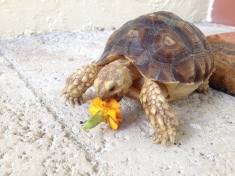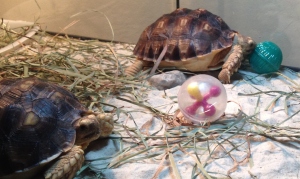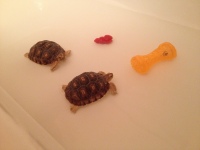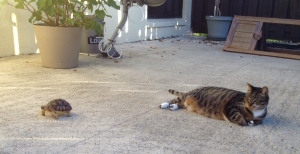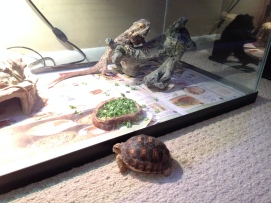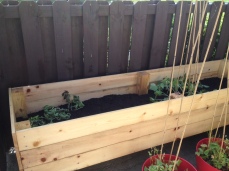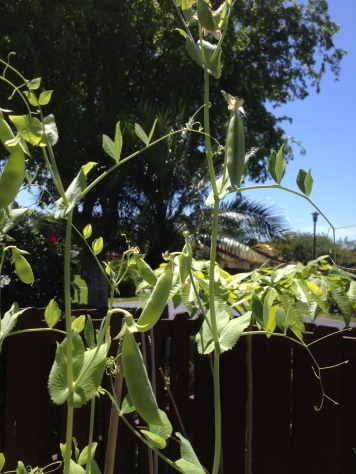 Some of you may have noticed that I haven’t posted any new articles for a while. First and foremost, thank you for sticking with me. I haven’t forgotten about you, the readers and followers. The tortoises are fine, great in fact. They are growing right before my eyes. The garden is a little empty at the moment though. One reason for this is because the South Florida heat has returned for the year. I had some gorgeous peas growing for a while and within three days of the scorching heat returning, all of my beautiful green peas turned into sad, brown, crispy leaf litter. The green beans weren’t far behind. Right now the citrus and purple sweet potatoes are really the only plants thriving in this heat and humidity. I do have some strawberries that are struggling too though. We shall see how that goes.
Some of you may have noticed that I haven’t posted any new articles for a while. First and foremost, thank you for sticking with me. I haven’t forgotten about you, the readers and followers. The tortoises are fine, great in fact. They are growing right before my eyes. The garden is a little empty at the moment though. One reason for this is because the South Florida heat has returned for the year. I had some gorgeous peas growing for a while and within three days of the scorching heat returning, all of my beautiful green peas turned into sad, brown, crispy leaf litter. The green beans weren’t far behind. Right now the citrus and purple sweet potatoes are really the only plants thriving in this heat and humidity. I do have some strawberries that are struggling too though. We shall see how that goes.
The heat is not my only reason for being MIA though. About two months ago I received a phone call that one of my best friends had died. It was unexpected and tragic and it truly broke me. Then, just when I thought things couldn’t get any worse, exactly five weeks later I received a text informing me that another friend had committed suicide. Between trying to grieve for both friends and help other loved ones deal with both losses I’m sure you can understand why blogging about my garden and the tortoises roaming it became less of a priority.
The details of both of my friends’ deaths are irrelevant, and while it really has nothing to do with tortoises or gardening, I wanted to talk a little about death and grieving. Although at the moment I am grieving the loss of two humans, many of us animal lovers also grieve the loss of pets. For people like us, “animal people”, pets become members of the family. As a vet tech, I saw people who truly felt that their animals were just as much members of the family as any human. There was a couple at the first hospital I worked at who had a cat. They spent a lot of money and a lot of time at our hospital. This cat was a child to them. After getting to know them, I found out that they had tried for many years to have children, even going through fertility treatments several times. Adoption did not work out for them either. So this cat became their child and it was their version of a family. And it was a good, happy family too. Another couple, at a different hospital, had a dog with all sorts of health problems. They were in and out of our hospital almost monthly. This dog was the most important thing in the world to them because this dog had belonged to their recently deceased son, who was also their only child. This dog was the last living reminder of the family they once had.
A while back a good friend of mine had a pet rat that died. When I told “animal people” about the passing of my friend’s rat, you could see the heartbreak and empathy in their eyes. When I told “people people” about my friend losing her pet rat, you could see the confusion and judgement in their eyes. Some even went as far as to say things like “Eewww” or “Why would anyone have a rat for a pet in the first place.” What “people people” don’t realize is how incredibly hurtful comments like this are to an “animal person.” And even though “animal people” care about all animals and are saddened when hearing about the injury, illness, or death of any animal, these comments sting even more when people are referring to someone’s pet, or rather a companion or member of the family.
So what is this “animal people” and “people people” nonsense I’m referring to, you ask? If you’re not familiar with the terms, they’re pretty common among veterinarians, vet techs, zookeepers, exotic pet hobbyists, and most others who are passionate about ALL animals. “Animal people” don’t just love animals. Instead, animals are a way of life. All animals from the tiniest frog or mouse, to the largest bear or elephant and everything in between are often times more important than most human beings to an “animal person”. Caring for these animals, learning about their behaviors, becoming conservation champions for them, and educating the rest of the world about the significance of animals are life goals. And it’s something you know in your heart even as a child. Most “animal people” are not as social with other people, though there are, of course, always some exceptions.
Most “animal people” have a difficult time talking about anything but animals. Even if the conversation starts out having nothing to do with animals, it only takes a short time until the topic comes up. Once we start, we don’t stop. And we have no problem talking about feces, anal glands, abscesses, maggots, or any other gross topic during dinner much to the chagrin of the “people people” at the table.
Last year I lost my bearded dragon, Odin, to cancer. I’ve lost other pets over the years including cats and dogs, but Odin’s death was particularly hard for me. I can’t explain it, but I was very attached to that little lizard. Though it’s been several months now, I still sometimes come home and find my eyes have immediately gone to the direction of where his enclosure used to sit. And I still find myself wanting him to hang out on the couch with me when I’m watching TV. And I still find myself looking behind me to see if he’s following me around the house like he used to do all the time.
Odin was surrendered to a local reptile rescue that a friend works with. She had him for literally about 5 minutes when she brought him to me. I took one look at him and decided he needed to come home with me. The only bits of information we knew about him were that he was nine years old and his name was Odin. I knew he was older, but decided that even if he was nearing the end of his life, he deserved to be loved and cared for as much as possible. The first 10 months were wonderful. He was the sweetest old man in the world.
He went into brumation and everything seemed OK. When he woke up a couple months later, I noticed a lump on his jaw. It was about the size of a pea. I watched it for a couple days, but it was getting larger, so to the vet we went. It appeared to be an average abscess.  The vet drained it and gave me some antibiotics to administer at home. At first it seemed to help, but then the lump came back. The vet drained it again, but it still came back. The vet recommended doing surgery to remove the abscess pocket to eliminate the problem. I agreed to the surgery and hoped for the best.
The vet drained it and gave me some antibiotics to administer at home. At first it seemed to help, but then the lump came back. The vet drained it again, but it still came back. The vet recommended doing surgery to remove the abscess pocket to eliminate the problem. I agreed to the surgery and hoped for the best.
However, the news I got was pretty bad. Once the vet had Odin under anesthesia and was able to do a full examination, she found a tumor growing on the inside of his lower jaw and she was not able to remove it. Over the next nine months, I frequently drained the abscess at home and administered antibiotics because the tumor was causing the abscess to recur. Odin was such a trooper through it all. He was always spunky and in good spirits. He never seemed to let all of the poking and prodding bother him. He even liked to go visit my other dragon, Matilda, and do push-ups and show off for her every day.
Finally the day came though. When I got home from work one day, I could tell by the look in his eyes and his body language that it was time. The spunk was gone. We went to the vet hospital and I stayed with him the whole time. Saying goodbye to him was one of the most difficult things I’ve ever had to do (until recently).
While my lizard and my friend’s rat may seem small and insignificant to many people, what those people tend to forget is that those animals are like family members to us. We spent months and years caring for them while they were healthy and dedicated even more time and love to them in the weeks and months that they were ill.
What I have found both with the passing of animal and human friends is that people are uncomfortable with grief. People who are grieving are afraid to show their feelings for many reasons like embarrassment or fear of showing weakness. Many people are also uneasy around a person who is grieving because they don’t know what to say or do. I am no expert by any means, but I will give the following advice:
For those of you who are grieving the loss of a loved one (human or animal), it is OK to feel whatever feelings you are having. And it is OK to express those feelings. Find someone to talk to and who will not judge you. For those of you in the presence of someone grieving, most importantly, do not judge the person. Everyone grieves differently and for different reasons (even if it’s for an animal). You may not understand the reasons, but you don’t have to. Just be there and listen. Don’t tell someone how he/she should feel or that they need to just move on or get over it (especially if it’s a pet since people tend to be less understanding in those situations). If you feel like you need to say something, just say “I’m sorry” or “I’m thinking of you.” Trust me, those words help more than any advice you could offer.
So if you are currently grieving the loss of a pet (or human) or have in the past, I truly am sorry. And please just always remember to be kind and don’t judge. Even the rat (or lizard) that may totally disgust you, may be the light of someone else’s life that has just gone out. Remember that that person is hurting and you can either be the person who helps or the person who hurts someone even more. It’s up to you how you react and respond.















